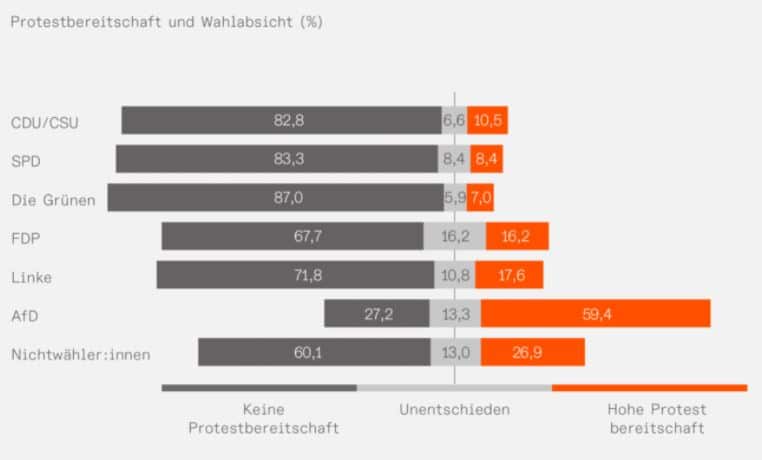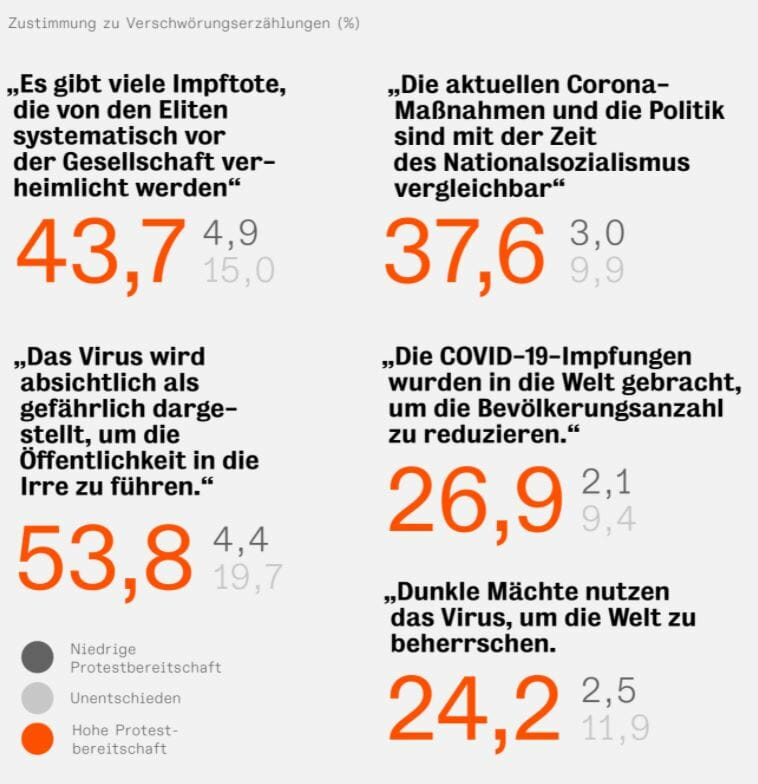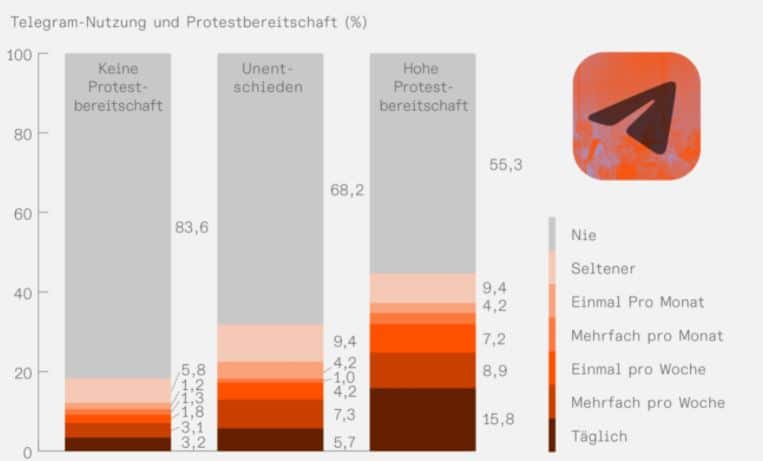So-called walks have been taking place for months, increasingly in front of politicians' houses. The CeMAS team has published a study in which the protests were examined and provides figures on voting preferences, belief in conspiracy and the number of protesters.
Note: This is a content/study from CeMAS Center for Monitoring, Analysis and Strategy gGmbH). CeMAS brings together interdisciplinary expertise on the topics of conspiracy ideologies, disinformation, anti-Semitism and right-wing extremism.
With the emergence of the Corona / COVID-19 pandemic, the conspiracy ideology and right-wing mobilization began in Germany, which was at least ostensibly directed against the state protective measures to contain the pandemic as well as the vaccinations.
From the beginning, right-wing extremist and conspiracy ideology actors and parties were involved in the mobilization. At the same time, there were local differences in the role the organized right played in the protests. This different mix makes it difficult for society, media and politics to classify and therefore leads to very different dealing strategies. In order to be able to provide an empirical answer to the protest milieu, CeMAS conducted a representative survey that deals with the protest participants and their attitudes.
Protest participation: Who is currently taking to the streets?
Various studies have looked at protest potential: that is, the willingness to take part in protests. However, there is no data yet as to whether people actually attended protests. Our analysis shows: 4.3% of respondents from Germany stated that they took part in the protests against the government's corona protection measures at least once. However, the willingness to protest and therefore the potential for mobilization is more than twice as high: a total of 11.1% of those surveyed said they would definitely or rather be willing to take part in these protests. Another 7.1% said they were partly thinking about it. 1
Our study also asked about the willingness to take part in illegal actions against the corona protection measures.
A total of 4.3% of those surveyed were completely or somewhat willing to take part in illegal activities. Another five percent said they were at least partially willing to do so. 13.7% somewhat or completely agreed with the statement “The time for peaceful resistance to the measures is over”, while a further 18.5% answered “partly/partly”. Vaccination status and corona infection: Among unvaccinated people, 69.2% said they would (somewhat) want to take part in the protests against the corona protective measures, while the figure was only 12.5% of vaccinated people with at least one vaccination against COVID-19.
Around ten percent were unsure. The more vaccinations the person received, the less willing they were to take part in the protests, r = -.560, p < .001.

Voter groups: While the vast majority of voters (at least 67.7%) of all democratic parties would not take part in the protests, almost sixty percent of AfD voters show a high willingness to protest.2 A similar pattern emerges when people say that the time for peaceful resistance is over. The highest approval ratings of 28.6% are among AfD voters, followed by 14.7% of SPD voters and 12.4% of Left-wing voters. The lowest approval ratings are among Green Party voters at 5.5%. 3
The willingness to take part in illegal actions against COVID-19 protective measures is also significantly higher among AfD voters than among all other groups. While approval for the AfD is 16.6%, voters of the other parties only agree to participation in illegal actions in the single-digit percentage range (between 1.2% for Die Linke and 3.3% for voters for the CDU /CSU).
What attitudes do the protesters and those willing to protest represent?

The dominance of conspiracy narratives in the context of the protest events was clearly visible - however, until now there were no reliable figures on the level of agreement among those protesting and those willing to protest. Our data shows very clearly that agreement with conspiracy narratives is significantly higher among those willing to protest than in the rest of the population. Among people with a low willingness to protest, only 4.9% agree with the statement that there would be many vaccine deaths that would be systematically hidden from society by the elites - a statement that 43.7% of people with a high willingness to protest agree with. The comparison of the current measures with National Socialism is only supported by 3.0% of those who have no interest in taking part in the protests, while 37.6% of people with a high willingness to protest support this historical revisionist attitude. 4
Protest behavior and Telegram
Telegram's role in mobilizing and spreading conspiracy narratives has been part of much reporting. However, data that deals with social media as a source of information and protest behavior does not yet exist. In this study we were able to collect this for the first time. The result: the higher the willingness to protest, the more likely Telegram was used as a source of information. While only 6.3% of people with a low willingness to protest said they would get information via Telegram daily or several times a week, the figure was 24.7% of those with a high willingness to protest.

Overall, it can be seen that the more people use Telegram in particular as a source of information, the more willing they were to protest, r = .324, p < .001, or to join in illegal actions, r = .297, p < .001 and the stronger did they agree with the different conspiracy narratives, r = .296, p <. 001. For other social media platforms, these effects were smaller or not significant.
Conclusion
More than four percent of people in Germany have already taken part in protests against the corona protection measures. However, the mobilization potential for such demonstrations is twice as high: more than one in ten people in Germany would be willing to take part in protests in the future. This is worrying because the pandemic is not over yet and the last two years have shown that the milieu is constantly reinventing itself and trying out different forms of protest. The introduction of compulsory vaccination is already being used for mobilization. A possible new wave in the fall could give it another boost. In addition, other conflicts and disasters can also be used for mobilization. The protesters may come from different backgrounds and appear heterogeneous from the outside, but within the protesters they perceive themselves as a unit (“one people”) that defends itself against the “enemies”. Our study also makes it clear once again: vaccination status (more likely unvaccinated), a strong belief in conspiracy and intention to vote (more likely AfD) play a role in the willingness to take part in protests. At almost all major protests from the milieu, CeMAS was able to observe a normalization of right-wing extremist positions.
The methodology for the study
In this study, a representative sample of the German population was asked about their attitudes and behavior. The focus of the survey was on conspiracy narratives and attitudes towards the containment measures in the COVID-19 pandemic. The recruitment of participants was planned so that the sample reflected the distribution in the overall population according to key parameters such as age, gender and federal state. 2,202 people over the age of 18 in Germany took part in the survey, which was carried out online by the market research institute Bilendi & respondi between January 17, 2022 and January 22, 2022. After data cleaning, the data of 1,970 people could be used. The survey was carried out using a standardized questionnaire, which, in addition to socio-demographic information on gender, age, school education, income, political attitudes and information on vaccination status, also contained measuring instruments to record political and ideological attitudes, the spread of conspiracy stories and protest events. Some of the measuring instruments have already been used in other surveys.
The data published here is part of a larger research project funded by the Alfred Landecker Foundation.
Footnotes
1 The results on protest potential are in line with other surveys that come to similar values such as COSMO (see https://projekte.uni-erfurt.de/cosmo2020/web).
2 The pattern is also confirmed for actual participation in the protests: While almost twenty percent of AfD voters said they had already been to protests, the values for all other parties are between two and three percent.
3 This statement is not clear and can be understood both normatively (“I think it is right that the time for peaceful resistance is over”) and descriptively (“I have the impression that the time for peaceful resistance is over”). We therefore carried out various statistical tests and were able to show that agreement with this statement, for example, correlates strongly with the willingness to take illegal actions, which rather indicates a normative understanding, r = .409, p < .001. However, the strength of the correlation differed significantly for, for example, voters of the SPD, r = .267, p < .001, compared to supporters of the AfD, r = .527, p < .001.
4 The same pattern can also be found among the people who were actually at the protests: They believed significantly more in conspiracy narratives and historical revisionist statements about the pandemic. However, since the number of protest participants in the representative survey only accounts for 4.3%, further statements about which attitudes this subgroup represents can no longer be statistically evaluated. In accordance with scientific standards, we therefore refrain from providing a detailed report of the percentage values here.
Publication date:
February 17, 2022 Authors: Pia Lamberty , Josef Holnburger and Maheba Goedeke Tort
Source: CEMAS
Notes:
1) This content reflects the current state of affairs at the time of publication. The reproduction of individual images, screenshots, embeds or video sequences serves to discuss the topic. 2) Individual contributions were created through the use of machine assistance and were carefully checked by the Mimikama editorial team before publication. ( Reason )

